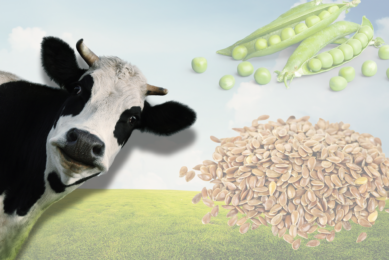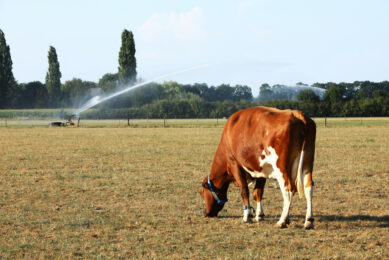Long-term effects of 3-NOP on CH4 and milk production

Unlike most studies that have focused on short-term supplementation of 3-nitrooxypropanol (3-NOP), the current study published in the Journal of Dairy Science determined the benefits of 3-nitrooxypropanol (3-NOP) on CH4 emission reduction and milk production when dairy cows are supplemented for a full year, covering all lactation stages and including the dry period.
Several reports highlight methane (CH4) emissions accounts for approximately 44% of the total greenhouse gas (GHG) emissions from dairy production, with enteric fermentation contributing more than 92%. Due to its considerable contribution, enteric CH4 production is the main target to reduce GHG emissions from the dairy sector. Several enteric CH4 mitigation strategies have been proposed, including changes in animal breeding and management, and dietary strategies such as improvement of forage quality, reformulation of diets, supplementing lipids, and rumen manipulation using feed additives.
One such feed additive, 3-nitrooxypropanol (3-NOP), has been reported to effectively reduce CH4 emissions. However, most studies have focused on short-term supplementation usually lasting 4 weeks or less; long-term studies are required to evaluate whether the CH4 mitigating effect of 3-NOP is persistent and whether potential adaptation of the rumen microbiota to 3-NOP occurs.
A full year of 3-NOP supplementation
Researchers of the current study determined the beneficial effect of 3-NOP on CH4 emission reduction and milk production characteristics from dairy cows receiving 3-NOP in their diet for a full year, covering all lactation stages including the dry period.
In this study, 64 late-lactation Holstein Friesian cows were allocated to 1 of 2 dietary treatments: a diet containing on average 69.8 mg 3-NOP/kg DM (total ration level, corrected for intake of non-supplemented GreenFeed bait) and a diet containing a placebo (Control diet without 3-NOP additive). The lactation diets (late lactation, LL; early lactation, EL; and mid-lactation, ML) used in the present study were representative of current practice in the Dutch dairy sector. The amount of concentrate, for example, depended on the lactation stage, being 44.5, 34.8, and 24.1% (on a DM basis) for the EL, ML, and LL diets, respectively.
Effect of 3-NOP on CH4 emissions
Overall, upon 3-NOP supplementation, a reduction of 21%, 20%, and 27% was achieved for CH4 production (g/d), yield (g/kg DMI), and intensity (g/ kg FPCM), respectively (FPCM is fat- and protein-corrected milk).
The CH4 mitigation potential of 3-NOP was affected by the lactation stage, on average, a 16%, 20%, 16%, and 26% reduction in CH4 yield (g/kg DMI) was achieved upon 3-NOP supplementation for the dry period, and early, mid, and late lactation diet, respectively.
The shifts in dietary ingredient composition across diets resulted in differences in chemical composition (e.g., dietary NDF content), and subsequently in variability in the mitigating effect of 3-NOP; previous studies show that adding 3-NOP to a high-quality diet inhibits methyl-coenzyme M reductase with greater efficacy, consequently resulting in a greater CH4 mitigation, compared with a low-quality diet. A high-quality diet is generally associated with a shorter mean retention time of the feed in the rumen, faster fermentation, and a tendency toward increased propionate production; this may result in fewer methanogens in the rumen and subsequently a lower concentration of methyl-coenzyme M reductase, the enzyme inhibited by 3-NOP.
Effect of 3-NOP on feed intake, body weight and body condition
In the current study, both the total dry matter intake (DMI) and the DMI of the partial mixed ration (PMR) were not affected by 3-NOP supplementation. In general, body weight gain might be caused by a shift in the ruminal fermentation profile and benefit from the retention of the prevented energy loss with CH4 emission, but, in the present study, both body weight and body condition scores were not affected by 3-NOP supplementation. However, 3-NOP supplementation resulted in increased feed efficiency (6.3% and 6.4% higher) measured either as kg FPCM / kg DMI total or as kg ECM / kg DMI total, respectively.
Effect of 3-NOP on milk production
Supplementation of 3-NOP resulted in increases in milk yield, milk fat, protein content, energy-corrected milk (ECM) and fat and protein-corrected milk (FPCM), as shown in Table 1. According to the researchers, the milk fat response likely resulted from a shift in rumen fermentation toward increased production of short-chain milk fatty acids precursors such as butyrate.
“Although not measured in the present study, similar studies observed an increase in ruminal proportions of butyrate upon 3-NOP supplementation which may also be an explanation for the results of the present study,” the researchers said. “Other studies have also reported a shift in the ruminal fermentation profile with 3-NOP resulting in increased proportions of ruminal propionate at the expense of acetate, which may further explain the milk protein response observed in the present study upon 3-NOP supplementation.”
They further explained that propionate is classified as glucogenic and the transfer efficiency of feed N into milk N may increase when glucogenic energy supply to the animal is increased, which is likely because of reduced catabolism of amino acids (AA) for gluconeogenesis, leaving more AA available for milk protein synthesis.
Main findings
- Supplementation of 3-NOP to the diet of dairy cows for 1 year, covering all lactation stages and the dry period, resulted in a reduction of 21%, 20%, and 27% for CH4 production, yield, and intensity, respectively.
- Although the efficacy of 3-NOP appeared to decline over time, there was an increased efficacy at the end of the trial.
- 3-NOP supplementation increased yields of milk fat, milk protein, energy-corrected milk and fat- and protein-corrected milk, and improved feed efficiency.
- The CH4 mitigation potential of 3-NOP was influenced by diet type, diet composition, nutrition value, and length of 3-NOP supplementation within a specific diet type (mainly in the early lactation diet).
This article is based on the publication ‘Long-term effects of 3-nitrooxypropanol on methane emission and milk production characteristics in Holstein Friesian dairy cows’ published in the Journal of Dairy Science, 2024.
Join 13,000+ subscribers
Subscribe to our newsletter to stay updated about all the need-to-know content in the dairy sector, two times a week.










